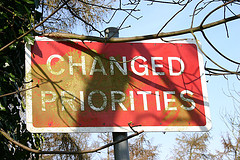In older days, “Clear the deck!” was a common command to prepare for doing battle at sea. The command focused attention, cleared visibility to gain a better perspective on the action, eliminated distractions and quickly channeled resources where they were needed most. Literally or figuratively, “clearing the deck” today serves virtually the same purposes.
Three developments inspired this article: First, and perhaps most closely linked to “clear the deck’s” original meaning, was the decision to sell our sloop on Lake Superior; it was time to make more room for other priorities and new adventures. (LOON now has a proud new owner who will take good care of her and take her on new journeys.) At about the same time a good friend described how being laid up for a period after surgery allowed him to “clear the decks” and think anew about his direction personally and professionally. Most recently, some interior home repairs and painting required moving way too many books, files, boxes, trip mementos, etc; a reminder that it is definitely time to “clear the decks” of clutter in our home and offices. We discovered many things with meaning or usefulness that no longer outweighed their required upkeep.
Not clearing the decks soon enough before early-day sea battles carried severe consequences. Maneuvering was awkward, vision and perspective were hampered, and valuable resources – including personnel – were lost. Actually, the decks usually got cleared eventually, early and intentionally or in defeat. Modern day sailors no longer need to clear decks in preparation for battle, but they do in preparation for storms; “prepare for a storm before the storm” by taking in sails, lashing gear down, “battening the hatches” and tying yourself in for the ride. Failures to clear the decks in those scenarios also extract serious consequences.
“Clearing the decks” for leaders and organizations today can  take the form of time for reflection and planning, questioning and reordering priorities, discarding what detracts from execution or no longer contributes value, or simply taking time away as a break or to see things differently. As Marcel Proust said, sometimes “A voyage of discovery is not in seeking new landscapes but seeing with new eyes.” (See inTEgro newsletter 05.26.09) Just as for naval commanders of old and present-day sailors, leaders and organizations that do not “clear the decks” from time to time will also likely be hampered by impaired vision, organizational clutter, restricted maneuverability and lack of focus. They will also likely miss out on innovations that new perspectives can bring and lose valuable talent.
take the form of time for reflection and planning, questioning and reordering priorities, discarding what detracts from execution or no longer contributes value, or simply taking time away as a break or to see things differently. As Marcel Proust said, sometimes “A voyage of discovery is not in seeking new landscapes but seeing with new eyes.” (See inTEgro newsletter 05.26.09) Just as for naval commanders of old and present-day sailors, leaders and organizations that do not “clear the decks” from time to time will also likely be hampered by impaired vision, organizational clutter, restricted maneuverability and lack of focus. They will also likely miss out on innovations that new perspectives can bring and lose valuable talent.
So how can leaders and organizations clear the decks today?
- First, recognize its importance. Kevin Cashman’s latest book The Pause Principle makes a strong business case for pausing, a form of clearing the decks. The dividends of “stepping back to lead forward” as Kevin puts it include developing leadership (vs. just management) capacities, more innovation, greater clarity out of complexity, alignment with purpose and increased engagement.
- Make time for it. At a personal / professional level options include short or longer beaks from routine or challenges. Organizational options include leadership and team retreats, strategic planning, GE-like “workout” processes and other disciplined practices for stepping back to gain perspective. Best practices in surgical settings today include the discipline of pre-surgical team meetings to increase clarity about the procedure, potential complications, processes and roles.
- Focus on the three Ps: purpose (what will best serve the mission,) priorities (Have they changed? What’s most important?) and principles (What is most aligned with our core values?) Those were pretty clear when clearing the decks for sea battles: some variation of carrying the day for God, honor and country. In the course of clearing decks today, leaders and their organizations will benefit from clarity around the purpose to be served, strategic goals and priorities, and core values to reinforce or at least not abandon.
- Challenge assumptions, decisions and directives. Prior to Microsoft’s and Apple’s breakout, had IBM challenged its assumption that there would never be a sufficiently large market for personal computers, they would have secured a far stronger market position. Had BP managers not assumed that their Gulf rig blowout preventer was functioning
 properly and other sufficient safety precautions taken, 11 rig workers wouldn’t have lost their lives. The Coast Guard and hospitals have adopted a practice that originated with aviation: the “two challenge rule:” If someone fails to adequately respond to two or more challenges about questionable observations or actions, it should be assumed that situational awareness has been lost and there is a need for remedial action. (See last month’s “Situational Awareness.”)
properly and other sufficient safety precautions taken, 11 rig workers wouldn’t have lost their lives. The Coast Guard and hospitals have adopted a practice that originated with aviation: the “two challenge rule:” If someone fails to adequately respond to two or more challenges about questionable observations or actions, it should be assumed that situational awareness has been lost and there is a need for remedial action. (See last month’s “Situational Awareness.”) - Practice discernment and dialog. Discernment is a more private version of dialog; both are practices for gathering sufficient information and exercising sound judgment to determine right courses of action. In both cases, relaxing assumptions, not hurrying solutions and examining broad possibilities are essential. Discernment and dialog are two of the “3 Ds and 3Cs” covered in more detail in my book Navigating Integrity – Transforming Business As usual Into Business At Its Best.
- Ask powerful questions. Asking provocative questions that challenge the status quo, and questions with no ready answers are important catalysts for discernment and dialog. Asking good questions is an essential leadership capacity since they open up possibilities and uncharted territories.
- Be ready to let go. I must admit, this is probably the hardest for me. I hold on to articles, books, files, other materials and ideas or approaches far beyond their usefulness. In most cases I mainly need to focus on my “3 ps” (above,) letting go of whatever else will not serve my future purposes, priorities and principles.
Sometimes, perhaps more in keeping with its original use, “Clear the deck!” is an urgent call to action. In his book A Sense of Urgency, John Kotter makes a strong case for how cultivating  a true sense of urgency is foundational for successfully executing change and growth strategies. He distinguishes a true sense of urgency from the complacency or false sense of urgency that usually accompanies unsuccessful change initiatives. Complacent organizations are comfortable with the status quo and blind to impending hazards or opportunities; a false sense of urgency is marked by frenetic and negative energy that is unaligned with clear, coherent strategies or rationales for change. Threats to survival and the urgency for action were all too apparent when the warships of old squared off. Today’s leaders need capabilities for “clearing the deck” that make the urgency for action in a perpetually changing, significantly more complex and nuanced environment more palpable.
a true sense of urgency is foundational for successfully executing change and growth strategies. He distinguishes a true sense of urgency from the complacency or false sense of urgency that usually accompanies unsuccessful change initiatives. Complacent organizations are comfortable with the status quo and blind to impending hazards or opportunities; a false sense of urgency is marked by frenetic and negative energy that is unaligned with clear, coherent strategies or rationales for change. Threats to survival and the urgency for action were all too apparent when the warships of old squared off. Today’s leaders need capabilities for “clearing the deck” that make the urgency for action in a perpetually changing, significantly more complex and nuanced environment more palpable.
How could you or your organization benefit from “clearing the decks?”
What are some actions that you can begin taking now to reap those benefits?
“Things which matter most must never be at the mercy of things which matter least.” (Johann Wolfgang von Goethe)
“The most important thing in life is knowing the most important things in life.” (David F. Jakielo)
